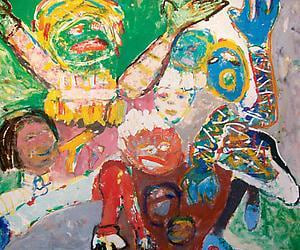George McNeil
Art in America, by Faye Hirsch
May 2011

There were just five George McNeil paintings in Perlow’s tiny space this winter, but even this small number made me wishfor a full-on museum exhibition of this underknown artist. The paintings date to the 1970s and 1980s, decades in which the New Yorker McNeil (1908-1995),who became an abstractionist in the late’30s and achieved renown as a second-generation Abstract Expressionist in the ’50s and ’60s, turned to a wild figuration that had affinities with that of the East Village and Neo-Expressionist painters. They were young and he was old, but he had the advantage in that he had little to work out. Having fully assimilated the muscularity and adventurousness of postwar abstraction, he could simply have a ball.
Maybe that’s one reason that, in the ’80s, he did a series of paintings and prints with a disco theme. There were two here: Dazzling Disco #2 (1984), with its muddled crowd and garish, masklike colored faces, and Dingbat Disco (1982), focusing on just two figures heatedly dancing. At around 4½ by 5 feet, this oil on canvas is thick with impasto and added materials—sand and twine—that, along with the primitivist, childlike facture and forceful brushwork, puts one in mind of Art Brut. The woman has bright yellow arms and a brown face; she thrusts one big pink leg over a tough wedge of blue. She looks one way while her partner, his head outlined in vivid orange, looks the other. The dance seems merely an excuse for the artist to give some nameable shape to the dynamic trajectories of his earlier nonobjective compositions—but something of the cocaine-stoked mania of the era has also made its way into the work.
I wish I knew what was going on in Are You Sure? (1984), another large painting in which the presence of a long, disembodied arm with a watch and two rather anxious-looking heads suggests an ominous narrative with a looming curfew. The toothy blue head at the center of the painting reminds me of figures by Dana Schutz and some recent “portraits” by Nicole Eisenman, similarly recalling Dubuffet, and makes me feel that the right context for McNeil could matter to younger artists who may not be familiar with his expressive intensity and humor. A smaller painting on paper mounted to panel (approx. 27 by 28 inches), Peter’s Dream Image, features another big, multicolored head, its spiky punkish hair aflame in pink and blue.
An earlier painting is less raucous: Holiday (1973) presents a distended, bleach-blonde blue nude nested in a hot orange ground—no light, but plenty of sun. At the height of second-wave feminism, McNeil cut off the cranium and made the mouth and pubic area a flaming red. At the time, painters like Baselitz were just making their way into U.S. galleries and museums, but his German angst had no edge over McNeil’s canny American lyricism. Once again, alas, market fashion prevailed.